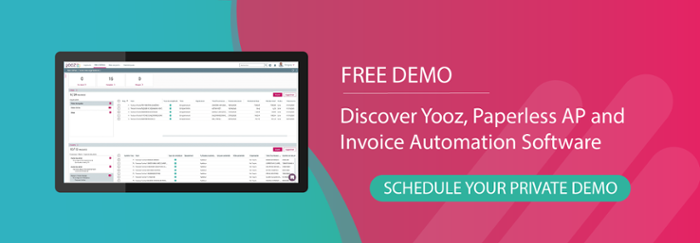Processing invoices is fundamentally about one thing: getting it right. That means making sure that every invoice is paid on time, every time. It might sound simple, but in the thick of things, mistakes and errors tend to slip through. Invoices from suppliers pile up; manual entry can cause delays; erroneous data needs to be corrected; payments need to be scheduled, and once paid, invoices need to be reconciled with purchase orders in your financial system or Enterprise Resource Planning (ERP) system.
That’s why it’s so crucial to have an intelligent workflow in place that is powered by automated invoice processing.
It takes the repetitive, heavy lifting out of human hands and instead relies on robotic process automation plus machine learning algorithms. The result is a streamlined workflow from purchase to payment that minimizes errors and risks, saves time and money, and empowers the entire company with valuable insights to optimize cash management.
Why Automation and Invoice Matching Go Together
The key to all this comes down to takings steps to consistently ensure that what you’re getting billed for on the invoice matches up with what you actually ordered. Depending on the type of invoice, the amount in question and the type of supplier relationship, a platform for accounts payable automation will use either 2 way, 3 way, or 4 way matching. These replace the historical "matching done by hand" process, creating a more precise, secure, scalable, and cost- efficient means of ensuring correct data.
And, for many organizations suffering from fluctuations in inflation or the ongoing hiccups in the supply chain, anything that improves cost-efficiency is front of mind. AP automation processing helps keep the cost pressures in check.
What is 2 Way Matching in Accounts Payable?
2 way matching is basically the entry-level requirement for any automated invoice processing system, a requirement that internal controls can’t live without. As the name implies, it means comparing 2 things (in this case an invoice from a vendor with an existing purchase order).
Both documents should contain identical information, such as the types, quantities, and prices of an order both parties agreed on, or vendor information such as address and banking information. The purchase order (PO) also has a unique number used for reference, tracking, and matching purposes that should show up on an invoice to guarantee faster processing.
If tolerance - differences between the customer or vendor payment - around those various fields are met, the invoice will be entered into the database and can be routed for review, approval, and eventually payment. While that’s a quick and easy way to catch errors, it provides only a basic level of security that can be cranked up if an order or a supplier require it.
One possible scenario is a first-time purchase from a new vendor who doesn’t have a track record with your company. Such cases may require additional checks to make sure everything is in order before you approve and initiate any payment.
3 Way Matching Enhances Security
If you bring in one more data set to validate an invoice, both accuracy and security increase. 3 way matching compares an invoice not only with a PO but also with a note of goods received. That third data source ensures that the products or services billed were ordered, billed, and indeed received as specified.
For example, if your organization ordered 100 chairs and was billed for the full amount but only actually received 75 of them, a 3 way automated matching process will immediately catch the discrepancy and escalate this exception for review by the Accounts Payable (AP) staff. It could be, for instance, that supply chain hiccups caused a delay in shipping the missing items or there was an error made in receiving, and the invoice can still be approved for partial payment.
Only if the numbers match up within the predefined tolerances will that invoice be routed for approval. If not, the AP system will flag it as an exception for further review. A modern platform for AP automation can perform 3-way matching very quickly and at scale. It drastically reduces the number of faulty invoices slipping through and speeds up handling the correct ones. As a result, processing costs per invoices drop by significantly and cycle times are measured in days or hours instead of weeks, making late payments a thing of the past.
4 Way Matching Takes It Up One More Level
Some invoices may require yet an additional level of checks and balances, and that’s where 4 way matching comes in. It compares the details from invoice, purchase order and receipt notes, and additionally requires some form of inspection information tied to quantity and quality.
This kind of matching is mostly called for when dealing with more complex products and services that involve quality control metrics, or when a particularly large or pricey order has been placed. As soon as all four categories pass the test, that invoice enters the AP workflow for further processing.
While 4 way matching is not the standard operating procedure, it can be easily handled by automated invoice processing. That’s because an intelligent platform is capable of reading rules around each invoice and then pulling all relevant data points quickly from an organization’s accounting, financial and ERP systems to perform precise matching at scale. Automated systems excel at pattern recognition, enabling businesses to minimize risks and save costs.
What Are the Additional Benefits of 2 Way Matching?
Paying every invoice on time, every time is a valuable thing in and of itself. Yet 2 way matching in accounts payable (and its more complex siblings 3 and 4 way matching) add ongoing value to daily operations in other ways as well.
Matching catches potential mistakes, duplicates, and fraud attempts early on without tying up precious labor down the road. It’s an efficient way to keep the cost of doing business in check and avoid bleeding cash when times are tough. For instance, automatically triggering a check-in with a vendor to verify a new bank account number or putting a hold on payment in case of discrepancy.
What’s more, 2 way matching increases visibility for the whole organization across the entire purchase-to-pay cycle. Automated invoice processing generates a constant stream of financial intelligence in real-time and makes it available in one central place. It helps everybody across departments stay in the know, even from a mobile device. Your organization is empowered to make better decisions, from cash management and purchasing to curating crucial vendor relationships and driving overall strategy.
There’s nothing to lose in this match. Automating internal AP controls at the level that suits your business needs is low-hanging fruit but will reap rich rewards and minimize several risks at once.
FAQs
What is 2-way matching in accounts payable, and how does Yooz handle this process?
How does Yooz ensure accuracy and efficiency in the 2-way matching process?
Can Yooz's 2-way matching capabilities adapt to the specific needs and workflows of our organization?
How does Yooz handle exceptions or discrepancies identified during the 2-way matching process?






